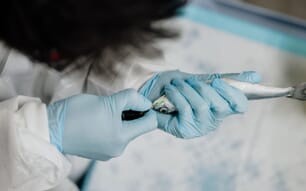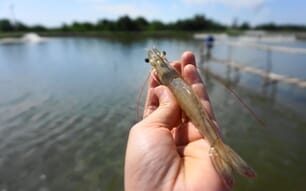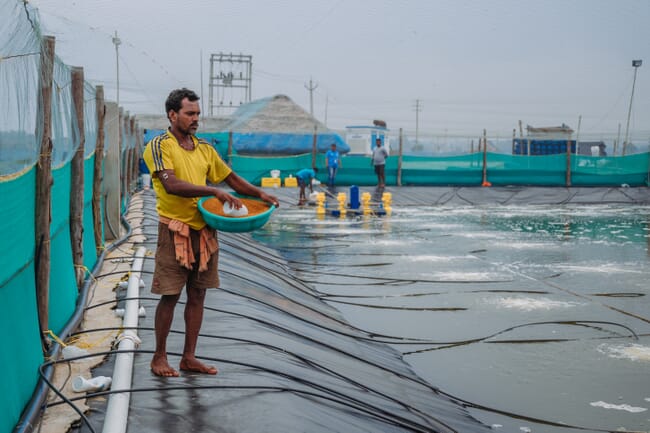
Speaking recently about the state of Asian shrimp farming, McIntosh – who is senior vice-president of Charoen Pokphand Foods – pointed out that while disease remains a concern, it is often farm management practices that determine whether a shrimp crop succeeds or fails.
“Three, four years ago farmers never talked about stress,” he observes. “Now every farmer talks about stress. They all understand this concept of stress and how when you have stress in a pond, the shrimp are going to get sick.”
This shift in awareness is crucial, he says, because stress is the common denominator behind most disease outbreaks in shrimp ponds. And while the presence of pathogens like Vibrio is unavoidable, the way ponds are stocked, aerated and fed largely determines whether shrimp can resist or succumb to them.
Stress and its sources
According to McIntosh, stress in shrimp ponds is typically man-made – with high stocking densities, overfeeding and inadequate aeration the main culprits.
Farmers who push their systems too hard in search of higher yields end up creating conditions where shrimp are constantly under pressure.
“Within that normalised disease background, you find very good farmers that basically don’t have issues, and then you have very bad farmers that have more than their share of issues. Every country you’ll find farmers that are outstanding and farmers that are lesser to the task,” he notes.
While diseases often become a convenient scapegoat, the real difference is the quality of management – by simply adapting feeding practices farmers can improve water quality, reduce Vibrio numbers and reduce disease.
Different genes, different feeds
With today’s improved shrimp genetics, shrimp are capable of growing faster than ever before. However, McIntosh warns that these animals also tend to overeat if feed is offered without limits.
“These newer stocks grow fast, they tend to overeat,” he explained. “When you’re monitoring consumption against what’s being eaten, you’re feeding a lot more than is needed. And that stresses the pond.”
The problem relates to the uneaten or poorly assimilated feed, with excess protein in ponds quickly breaking down into toxins, creating a stressful environment.
“What stresses them is the toxins in the water. You put in these high-protein feeds and protein, if you’re not using it, decomposes into toxins in the pond. Nitrogen toxins. That’s stress,” McIntosh emphasises.
To counter this, more farmers are learning to cap feeding rates – deciding on a maximum daily input and sticking to it, even if shrimp seem hungry.
“What you find in farms like this is the shrimp always look hungry,” he said. “They look like they’re crawling out of ponds looking for food. But when you look at the results, FCRs are low, growth rate is very fast, survival is higher with less disease and, of course, their feed bill is much lower because they’re not overfeeding.”
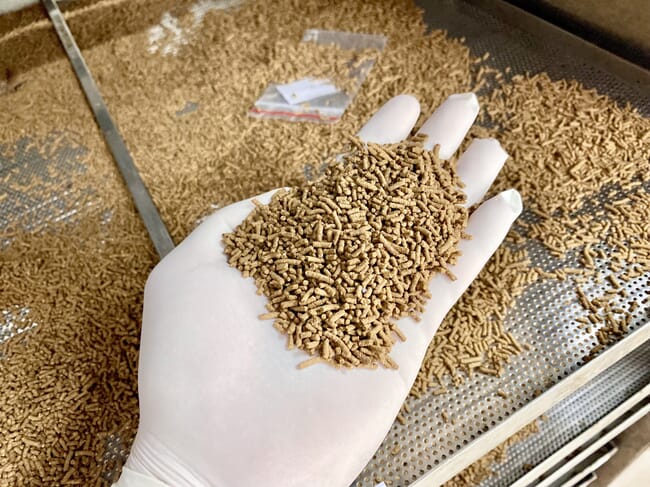
© ShrimpVet
Rethinking protein levels
Beyond feeding rates, McIntosh believes the industry needs to rethink the protein levels in shrimp diets. Many countries in Asia still use feeds with protein levels above 40 percent – in some cases because of regulations, in others because of ingrained habits and feed company influence.
“To do the growth rates that we do, we don’t need a 40 percent protein, a 42 percent protein,” he argues. “With that high protein, you’ll never get a high protein assimilation efficiency. So there’s a lot of protein decomposing in the pond and nitrogen, and that’s toxic.”
Instead, feed protein should be aligned with the actual growth rates achieved on farms: for those farms achieving an average daily gain (ADG) of 0.3 grams per day, 28–30 percent protein is enough; for those achieving or 0.4 grams per day, 35 percent protein is appropriate; and only for very high gains, 0.7–1 gram per day – achievable in controlled centres but rarely on farms – does 40–50 percent protein make sense.
“If you add more protein to a 0.3-gram farm, you’re not going to get 0.5 grams,” he explained. “You’re probably going to make it slower and you’re probably going to lose more shrimp along the way.”
This perspective challenges long-standing assumptions that more protein equals faster growth and healthier shrimp.
“It mystifies me,” McIntosh reflects, “that in Vietnam with all the stress issues they show, they insist on high 40 percent-plus diets. It’s erroneous because it’s probably not the protein level holding back the growth rate – it’s the environment and the stress in the pond.”
Lower densities, greater success
One area where McIntosh sees positive change is in stocking practices. For years, many farms chased ultra-high densities of 200–300 shrimp per square metre in pursuit of massive harvests. But in reality, such intensification has often led to widespread failures.
“I’m loving seeing the trend of lower stocking density,” he says. “I’m loving seeing the trend of understanding we’re dealing with Vibrio. And understanding that the only way to deal with Vibrio is by limiting its food supply.”
“For the first time in years, I see the average density numbers coming down,” he adds. “Instead of 200, 250, 300, bringing them down under 110 – and some of them going to 90 and 80. That’s positive because they’re not shooting for the 50 tonnes per hectare, the 100 tonnes. Shoot for an honest 25–30 tonnes per hectare, which is a lot of shrimp, and you can be consistent.”
Consistency, he argues, is far more valuable than the occasional mega crop followed by multiple failures.
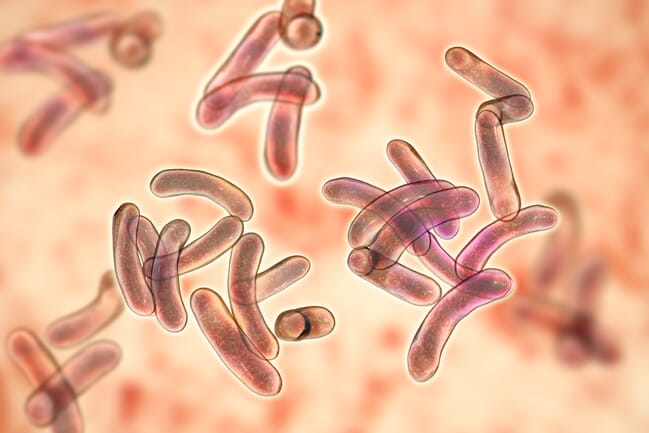
Vibrios are a catalyst for many forms of shrimp disease, according to McIntosh
Living with Vibrio
While many pathogens plague shrimp farming, McIntosh singles out Vibrio bacteria as the most significant threat today, with diseases like white spot or EHP often become more lethal when Vibrio is present.
“EHP without Vibrio is not much of a disease. You mix Vibrio with the EHP and now you’ve got the disease that everybody talks about,” he explains.
The only sustainable way to control Vibrio, he stresses, is through better pond management, not antibiotics.
“Vibrio can only grow if they have food. And the food for Vibrio is the excess nitrogen, the excess organics from feeding, the higher stocking rates,” he observes.
Take-homes for farmers
McIntosh’s message for farmers is that healthier ponds and stress-free shrimp are possible if they focus on the basics, namely:
- Reducing stress by moderating stocking densities and ensuring sufficient aeration.
- Capping feeding rates, even if shrimp appear hungry, to avoid build-ups of toxins in pond water.
- Lowering feed protein levels to match actual growth rates instead of following outdated assumptions or feed company advice.
- Controlling Vibrios by limiting excess nutrients in ponds rather than relying on antibiotics.
- Aiming for consistency, not record-breaking yields, by keeping stocking densities at manageable levels.



